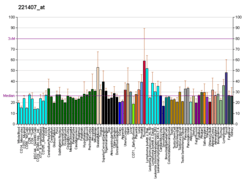GJD2
Gap junction delta-2 protein (GJD2) also known as connexin-36 (Cx36) or gap junction alpha-9 protein (GJA9) is a protein that in humans is encoded by the GJD2 gene.[5][6]
Function
GJD2, also called connexin-36 (CX36), is a member of the connexin gene family that is expressed predominantly in mammalian neurons. Connexins associate in groups of 6 and are organized radially around a central pore to form connexons. Each gap junction intercellular channel is formed by the conjunction of 2 connexons. See GJB2 for additional background information on connexins.[6]
References
- 1 2 3 GRCh38: Ensembl release 89: ENSG00000159248 - Ensembl, May 2017
- 1 2 3 GRCm38: Ensembl release 89: ENSMUSG00000068615 - Ensembl, May 2017
- ↑ "Human PubMed Reference:".
- ↑ "Mouse PubMed Reference:".
- ↑ Belluardo N, Trovato-Salinaro A, Mudo G, Hurd YL, Condorelli DF (Oct 1999). "Structure, chromosomal localization, and brain expression of human Cx36 gene". J Neurosci Res. 57 (5): 740–52. doi:10.1002/(SICI)1097-4547(19990901)57:5<740::AID-JNR16>3.0.CO;2-Z. PMID 10462698.
- 1 2 "Entrez Gene: GJA9 gap junction protein, alpha 9, 36kDa".
Further reading
- Andrew L Harris; Darren Locke (2009). Connexins, A Guide. New York: Springer. p. 574. ISBN 978-1-934115-46-6.
- de Brouwer AP, Pennings RJ, Roeters M, et al. (2003). "Mutations in the calcium-binding motifs of CDH23 and the 35delG mutation in GJB2 cause hearing loss in one family". Hum. Genet. 112 (2): 156–63. doi:10.1007/s00439-002-0833-0. PMID 12522556.
- Martin D, Tawadros T, Meylan L, et al. (2004). "Critical role of the transcriptional repressor neuron-restrictive silencer factor in the specific control of connexin36 in insulin-producing cell lines". J. Biol. Chem. 278 (52): 53082–9. doi:10.1074/jbc.M306861200. PMID 14565956.
- Bathelier C, François M, Lucotte G (2004). "Neonatal detection of the 35delG mutation of the GJB2 gene in families at risk for deafness". Genet. Couns. 15 (1): 61–6. PMID 15083701.
- Degen J, Meier C, Van Der Giessen RS, et al. (2004). "Expression pattern of lacZ reporter gene representing connexin36 in transgenic mice". J. Comp. Neurol. 473 (4): 511–25. doi:10.1002/cne.20085. PMID 15116387.
- Mas C, Taske N, Deutsch S, et al. (2004). "Association of the connexin36 gene with juvenile myoclonic epilepsy". J. Med. Genet. 41 (7): e93. doi:10.1136/jmg.2003.017954. PMC 1735851. PMID 15235036.
- Dobrenis K, Chang HY, Pina-Benabou MH, et al. (2006). "Human and mouse microglia express connexin36, and functional gap junctions are formed between rodent microglia and neurons". J. Neurosci. Res. 82 (3): 306–15. doi:10.1002/jnr.20650. PMC 2583240. PMID 16211561.
- Hempelmann A, Heils A, Sander T (2006). "Confirmatory evidence for an association of the connexin-36 gene with juvenile myoclonic epilepsy". Epilepsy Res. 71 (2–3): 223–8. doi:10.1016/j.eplepsyres.2006.06.021. PMID 16876983.
- Aleksic B, Ishihara R, Takahashi N, et al. (2007). "Gap junction coding genes and schizophrenia: a genetic association study". J. Hum. Genet. 52 (6): 498–501. doi:10.1007/s10038-007-0142-5. PMID 17427027.
This article is issued from
Wikipedia.
The text is licensed under Creative Commons - Attribution - Sharealike.
Additional terms may apply for the media files.




